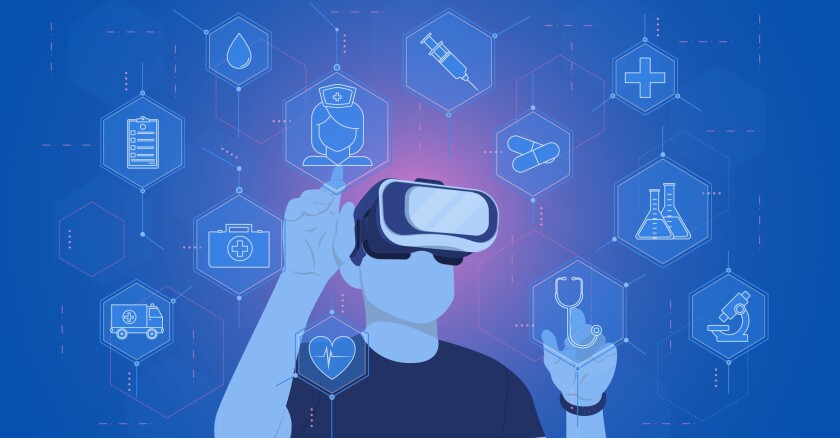Science
Ohio Universities Integrate AI and VR into Healthcare Education

Healthcare education in Ohio is experiencing a significant transformation with the integration of artificial intelligence (AI) and virtual reality (VR) technologies into curricula. This initiative aims to prepare future healthcare professionals by providing them with immersive experiences that closely resemble real-world scenarios before they engage with actual patients.
At **Cedarville University**, the nursing program has embraced this innovative approach, thanks in part to a grant from **Bodyswaps**, a London-based company specializing in AI and VR solutions for soft skills development. According to **Nate Kincaid**, an associate professor of nursing, the introduction of VR headsets and training platforms allows students to practice essential soft skills—such as empathy and effective communication—through interactions with computer-generated patients. These simulations cover a variety of scenarios, including delivering difficult news to patients, and are designed to provide feedback on crucial interactions, such as eye contact and phrasing.
The use of AI in healthcare education is not limited to Cedarville. **Dr. Yi-Hui Lee**, a faculty professor at **Wright State University’s** college of nursing, highlights the potential of AI to create personalized learning experiences. AI technologies can analyze student progress, identify weaknesses, and automatically generate tailored learning plans. This not only enhances the educational experience but also frees healthcare professionals from administrative burdens, allowing them to focus more on patient care.
AI is revolutionizing not only education but also practical healthcare delivery. Tools such as voice recording, instant transcription, and data summarization enable healthcare providers to spend more time with patients rather than on paperwork. “Healthcare providers can intercede earlier, making healthcare predictive instead of reactive,” Lee noted. This is particularly critical given the ongoing nursing shortage, which places additional pressure on healthcare managers to improve patient outcomes.
Despite the advantages of AI, Lee cautions that it is not a panacea. Ethical considerations and potential biases in data sets used to program AI systems necessitate human oversight. For instance, a treatment recommended based on data from a predominantly white population may not be suitable for patients from diverse backgrounds. “It’s a tool. It’s not to replace us,” she emphasized, highlighting the importance of maintaining human judgment in medical decisions.
In a further demonstration of Ohio’s commitment to integrating AI in education, **Sinclair Community College** has launched a $5 million initiative known as the AI Excellence Institute. This strategic program aims to incorporate AI training across all disciplines, preparing students to engage critically with AI technologies, much like the early adoption of the internet in higher education. **Christi Amato**, dean of eLearning, remarked, “Students need direct AI training regardless of what discipline they’re studying.”
Sinclair’s health sciences program employs AI to create realistic simulations that allow students to practice crucial skills in a risk-free environment. As **Wendy Moore**, program director, stated, “You can read a book all day, but it doesn’t give that real-life experience.”
Additionally, **Miami University** is receiving a $1.5 million grant from the **Ohio Bureau of Workers’ Compensation** to develop the Safety Immersion and Gamified Hazard Training (SIGHT) program. This initiative aims to enhance safety training for manufacturing workers by combining AI, VR, and augmented reality. The project will ultimately provide customized hazard simulations based on specific work environments, contributing significantly to the safety and productivity of the workforce.
**Mohammed Mayyas**, chair and professor of Engineering Technology, emphasized the hub’s role in advancing safety technologies in real manufacturing settings. “The AM Hub will serve as a hands-on, interdisciplinary ecosystem where students, faculty, and industry partners collaborate,” he said.
As Ohio universities lead the way in integrating AI and VR technologies into healthcare education, these initiatives are expected to pave the way for a new generation of healthcare professionals equipped with the skills necessary to thrive in a rapidly evolving landscape.
-

 Entertainment2 weeks ago
Entertainment2 weeks agoAndrew Pierce Confirms Departure from ITV’s Good Morning Britain
-

 Health4 months ago
Health4 months agoNeurologist Warns Excessive Use of Supplements Can Harm Brain
-

 Health4 months ago
Health4 months agoFiona Phillips’ Husband Shares Heartfelt Update on Her Alzheimer’s Journey
-

 Science2 months ago
Science2 months agoBrian Cox Addresses Claims of Alien Probe in 3I/ATLAS Discovery
-

 Science2 months ago
Science2 months agoNASA Investigates Unusual Comet 3I/ATLAS; New Findings Emerge
-

 Entertainment1 week ago
Entertainment1 week agoGogglebox Star Helena Worthington Announces Break After Loss
-

 Entertainment1 month ago
Entertainment1 month agoTess Daly Honoured with MBE, Announces Departure from Strictly
-

 Science2 months ago
Science2 months agoScientists Examine 3I/ATLAS: Alien Artifact or Cosmic Oddity?
-

 Entertainment3 months ago
Entertainment3 months agoLewis Cope Addresses Accusations of Dance Training Advantage
-

 Entertainment5 months ago
Entertainment5 months agoKerry Katona Discusses Future Baby Plans and Brian McFadden’s Wedding
-

 Science2 months ago
Science2 months agoNASA Investigates Speedy Object 3I/ATLAS, Sparking Speculation
-

 Entertainment5 months ago
Entertainment5 months agoEmmerdale Faces Tension as Dylan and April’s Lives Hang in the Balance









